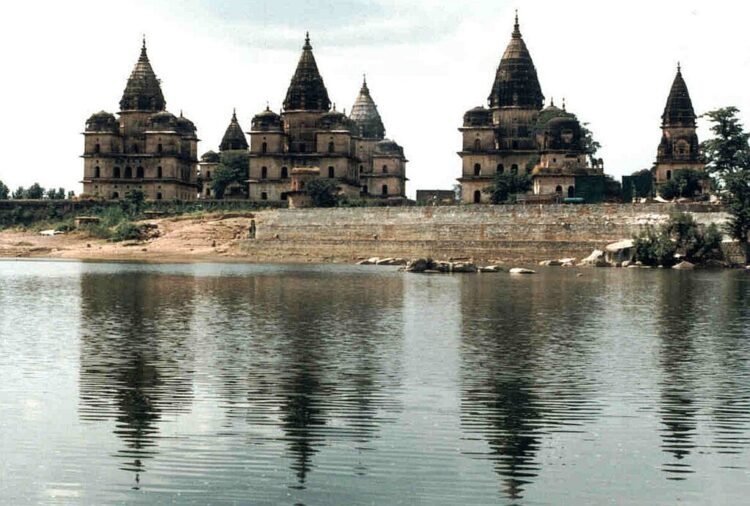No products in the cart.
INCREDIBLE ORCHHA IN HEART OF INDIA
Medieval Legacy in Stone, The magical city of Orchha, known as Osseen in ancient times, lies in the central Indian state of Madhya Pradesh. It lies roughly 16 kms from the town of Jhansi in Uttar Pradesh. There is an interesting tale that the residents of Orchha tell about Jhansi: the name apparently comes from Jhan-si or shadow-like, the remark that an Orchha king made on the town.
The Winters on the door, thik about place to visit during November to Februray, Orchha is a land shrouded in mystery. Its very name, according to many means hidden. Some believe that the land derives its name from the remark of a Rajput chief who upon sighting, the land, exclaimed ‘Ondche’ or ‘ it lies’low or far enough’. The city was once impregnable which tells us that the Mughal forces, despite their military prowess could not enter Orchha because it was naturally defended by ragged mountains, dense forests and the river Betwa.
Places to See
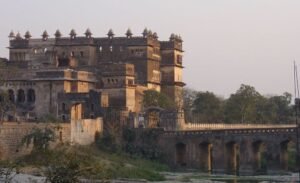
Orchha Fort: The fort complex is within an island formed by the confluence of the Betwa River and Jamni River in Orchha town approached from the eastern part of the market in the town through a multiple arched bridge with 14 arches built in granite stones. Jehangir Mahal, Raj Mahal, Sheesh Mahal and Rai Praveen Mahal are part of the Fort complex.
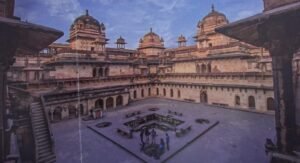
Jehangir Mahal: Jahangir Mahal has 236 chambers laid around a vast, central courtyard, out of which a total of 136 lie underground. The floors are arranged in tiers that ascend or descend in a random yet spectacular manner. This, accompanied by massive bastions in its four corners, tends to make the palace look like a fort from the outside-uniform, sturdy, solid and impenetrable- defended by a massive wooden gate that completes its fort like aura.
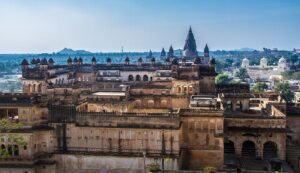
Raja Mahal: Standing adjacent to Jahangir Mahal, is the much older Raj Mahal with an east-facing entrance. It is said to have been built by Raja Madhukar Shah (1554-1592) the father of Bir Singh Deo. Though Percy Brown dates it to 1575, many believe that its construction was begun by Raja Rudra Pratap Singh (1501-1530) and the structure taken to its lofty heights by his son and successor Raja Bharti Chand (1531-1554). On the top floor, you can see the remains of exquisite mirror work on the walls when sunlight falls on its they produced a combined effect of lighting in the entire chamber. Reflecting the mixture of Rajput & Mughals architecture the Raja mahal houses 2 audience halls the Darbar e khas & the Darbar e aam with striking work of stone jali.
Rai Praveen Mahal: Rai Praveen Mahal was built in honor of Rai Praveen, the beautiful paramour of Raja Indrajit. The reputation of her beauty and talent had reached the Mughal court; and emperor Akbar wished to see her. Raja Indrajit did not relent and he was threatened by Akbar with a fine of one crore rupees. At this, the litterateur- poet Keshav Das was told to accompany Rai Praveen to the Mughal Court at Agra.
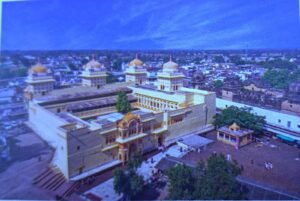
Ram Raja Temple: Ram Raja Temple does not look anything like a regular Hindu temple. This is because it was originally the palace of Rani Ganeshkumari, wife of Raja Madhukar Shah and was known as Rani Mahal. The Imperial Gazetteer e of the finest buildings in Orchha.
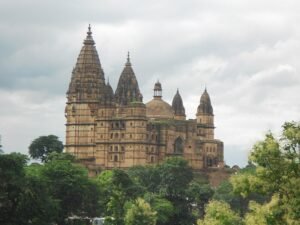
Chaturbhuj Temple: Chaturbhuj Temple,lying to the south of Ram Raja Temple, was where the idol of Ram was originally supposed to be enshrined.
The temple dominates the town of Orchha by its sheer size. Its towering shikharas seem to reach out to the sky. Built on a 4.5 m high platform one has to climb a fleet of steps to reach the temple.
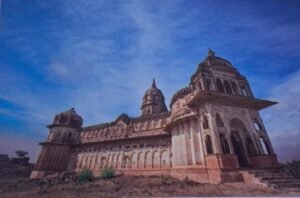
Laxminarayan Temple: Laxminarayan Temple was built by Bir Singh Deo and later renovated by Raja Prithvi Singh C.1793. This temple is truly unique as it blends temple and fort architecture.
Constructed with lime mortar and bricks, the structure has cannon slots on its roof. It is unclear whether these were part of the original temple.
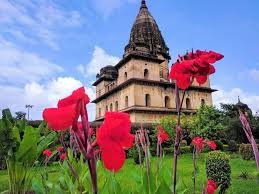
Phool Bagh: Laid out as a formal garden, this complex testifies to the refined aesthetic qualities of the Bundelas. A central row of fountains culminates in an eight- pillared palace-pavilion. A subterranean structure below was the cool summer retreat of the Orchha Kings. An ingenious system of water ventilation connected the underground palace with Chandan Katora, a bowl-like structure from whose fountains droplets of water filtered through to the roof, simulating rainfall.
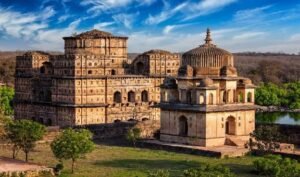
Diwan Hardaul’s Palace: Diwan Hardaul’s Palace, with its domes, delicate pillars and mossy spires, stands to the north of Ram Raja Temple. Its walls are painted a melacholy yellow. Astone vessel stands right in front of the palace. According to local folklore, the vessel was filled with chanderi or sandalwood paste every morning.
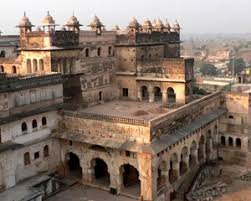
Sunder Mahal: This small palace, almost in ruins today, is still a place of pilgrimage for Muslims. Dhurjaban, son of Jhujhar, embraced Islam when he wed a Muslim girl at Delhi. He spent the latter part of his life in prayer and meditation and came to be revered as a saint.
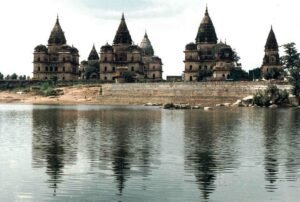
Chhatris (Cenotaphs): Chhattris are cenotophs of the rulers of Orchha belonging to the Bundela Clan. There are a total of 14 cenotaphs dating from 16″ to 18″ Centuries. Most of the cenotaphs except that of Bir Singh Deos are built like temples with a chamber in the middle with four chambers at the four corners of the courtyard, the Shikhar of the cenotaphs also resemble those of temples of Nagar style. Bir Singh Deo Chhatris is more like a palace.
Shahid Smarak Commemorates the great freedom fighter Chandrashekhar Azad who lived and worked in hiding in Orchha during 1926 and 1927. Other places worth seeing in Orchha are the shrines of Siddh Baba ka Sthan, Jugal Kishore, Janki Mandir and the Hanuman Mandir at Ohharedwara.
Heritage Walk: For exploring the beauty of Orchha on foot one may contact office of State Archeology, Orchha.
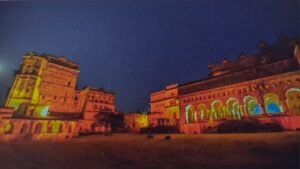
Sound & Light Show: The sound & light show at Orchha is a thrilling experience which takes one through pages of history. It narrates the discovery of Orchha by a king on hunt and the rise & fall of the mighty kings, great battles, saucy romances & feats of valour. The narration will take you through the exciting tales of defiance, loyalty & ambition and stories of saintly Queens. The show also gives you an interesting insight into the architecture, wall paintings & culture of Bundelkhand.
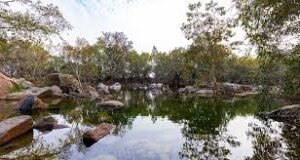
Orchha Bird Sanctuary: It’s one of the most scenic sanctuaries in Madhya Pradesh. Spread over an area of around 46 sq.km, the Sanctuary gains importance due to rich avifauna, Betwa River and some rare varieties of plants.
TARAgram: The centre is dedicated to using biomass, waste- materials and other local raw materials, to provide solutions to create environment friendly products like handmade paper.
Shopping Tikamgarh is famous for Metal Craft using cire perdue, or lost- wax process. The craft traditionally practiced now serves the tourist in the form of bells decorative weapons, idols, masks etc which can be purchased as souvenir
How to Reach
By Air: Nearest Airport is Gwalior (119 km), and Khajuraho (170 km).
By Road: Orchha lies off the Jhansi-Khajuraho road.
By Rail: Nearest railhead is at Jhansi (16 km), on the Mumbai – Delhi and Delhi – Chennai main lines. Khajuraho (170km) is the other nearest railhead which connects Delhi with UP Sampark Kranti express. All major mail and express trains stop at Jhansi. Other railhead is at Satna (90km).


